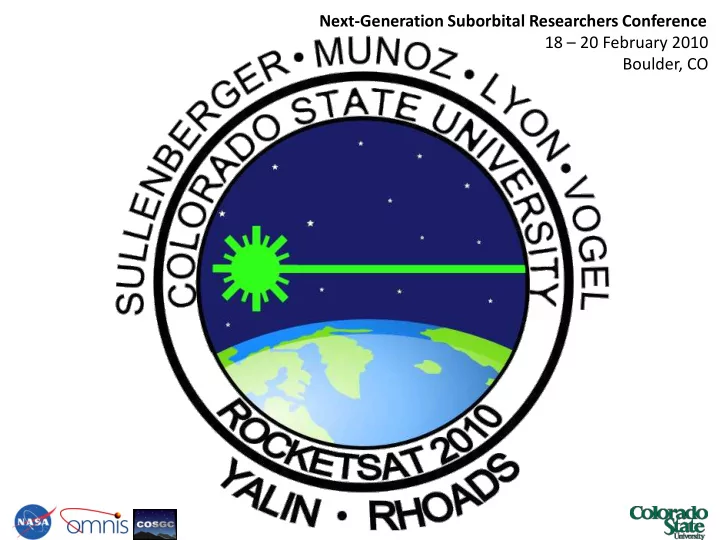

Next-Generation Suborbital Researchers Conference 18 – 20 February 2010 Boulder, CO
Introduction and Background Preliminary Testing Design Future Work If given the opportunity to conduct an experiment in microgravity, WHAT WOULD WE DO?
Introduction and Background Preliminary Testing Design Future Work The Problem and Proposed Solution No current, acceptable solution exists to determine liquid volume in a tank exposed to microgravity, without some form of stratification, tank stirring or spacecraft acceleration An optical mass gauge is a viable option Normal Gravity Microgravity
Introduction and Background Preliminary Testing Design Future Work Alternative Methods Alternative Method Basics Requirement Capacitive Sensor Permittivity of the cryogenic fluid is related to Settling / the volume within the tank. Stratification Liquid-Level Diode A strip of silicone diodes are brought to a Settling / Sensor certain temperature. Time constants allow for Stratification fluid volume measurement. Multipin Plug Vapor Cryo-Liquid Diodes Optical mass gauge will not require settlement or acceleration of spacecraft
Introduction and Background Preliminary Testing Design Future Work CSU’s Microgravity Experiment Objective: Design, fabricate, and successfully flight-test an optical mass gauge sensor capable of accurately determining liquid volumes contained within a tank exposed to any gravitational environment. We are currently working in cooperation with NASA’s Marshall Space Flight Center to produce a rugged and miniaturized optical mass gauging platform for launching on a sounding rocket.
Introduction and Background Preliminary Testing Design Future Work Basic Interferometry Mach-Zehnder Interferometer The amount of space occupied by a fluid inside a tank is determined by measuring the index of refraction of a gas within the system. This is done by using an interferometer which operates by analyzing the interference pattern generated by two or more optical signals
Introduction and Background Preliminary Testing Design Future Work Theory of Operation At first, a piston pressurizes the gas cell, producing a reference fringe count Reference Beam Gas Cell (V 1 ) Detector Sensing Beam V t Piston (V P )
Introduction and Background Preliminary Testing Design Future Work Theory of Operation A tank is then exposed to the measurement system, and a second piston cycle produces corresponding fringe count Reference Beam Gas Cell (V 1 ) Detector Sensing Beam V Tank (V 2 ) t Piston (V P ) The fringe counts can then be related to volumes using the mathematical relationship: where V 1 is the volume of the gas cell, V P is the volume of the piston, and V 2 is the ullage volume of the tank
Introduction and Background Preliminary Testing Design Future Work Initial Mach-Zehnder Interferometer Beam Splitter 2 Mirror 2 Ref. Beam Gas Cell Mirror 1 Signal Beam Beam Splitter 1 Interferometer was constructed at the CSU Engineering Research Center (ERC) using a Helium-Neon Laser at 543.5 nm (Green Light)
Introduction and Background Preliminary Testing Design Future Work Demonstrative Fringe Shift Interference Constructive Shift Destructive Point of Reference
Introduction and Background Preliminary Testing Design Future Work Fringe Shift of Mach-Zehnder Interferometer For The Initial prototype setup: λ 543.5 nm A 4.606 x 10 -6 (m 3 /mol) = 33 fringes theoretical R 8.314 (J/K*mol) l 0.0762 m Visually counted 36 5 fringes with lab setup T 297 K P 84 kPa Good agreement between initial experiment and calculation
Introduction and Background Preliminary Testing Design Future Work Fiber-Optic System Weight Size Vibration C.O.G. Cost Complexity Manufacturing Total Concept Type Resistance Conformity Ease Traditional Optics (Mirrors, Beam Splitters) 1 1 1 2 3 2 1 11 Fiber Optics 3 3 3 2 1 1 3 16
Introduction and Background Preliminary Testing Design Future Work System Layout Two tanks w/ different volumes of liquid are independently exposed to Gas Cell Amount of liquid in each can be determined The two tanks represent fuel/fluid levels at different periods during a mission
Introduction and Background Preliminary Testing Design Future Work Data Handling and Control Voltage readout from Photodiode sent to custom- made electronics board Utilizes Atmega 2561 and Atmega 8515, 16bit Analog to Digital Converter All electronics duplicated, data recorded to 4x 4GB uSD flash mem (redundant in case of failure)
Introduction and Background Preliminary Testing Design Future Work Solid Model of Flight-Ready Prototype Tanks Laser Diode Mount Actuator Piston Solenoid Valves Gas Cell
Introduction and Background Preliminary Testing Design Future Work Construction of Prototype Photodiode (output) Second stage First stage
Introduction and Background Preliminary Testing Design Future Work Testing • Comprehensive Leak Testing Pressurize the Tanks, Piston Chamber, Gas Cell, Lines to 40psi • Vibration and Acceleration Testing (Sierra Nevada Corp.) 20 minute run with payload placed vibration table in all 3 axes. • Full Mission Simulation Including Compete Data Collection and Analysis
Introduction and Background Preliminary Testing Design Future Work Summary Introduced problems with measuring liquids in zero-g, alternative methods currently in use, theory of optical mass gauging Team Status Nearing end of prototype manufacturing, beginning testing phase Overall Goal Mature an existing technology for fuel measurement through a flight test
Introduction and Background Preliminary Testing Design Future Work Acknowledgments • Tim Schneider, Colorado State University (electronics) • Dr. Valentine Korman, K-Science • Dr. Kurt Polzin , NASA’s Marshall Space Flight Center • Jason Priebe and Lad Kurtis, Sierra Nevada Corp. • Omnis Inc. • Colorado Space Grant Consortium • Colorado University RocketSat Program • Colorado State University Senior Design
Questions?
Recommend
More recommend